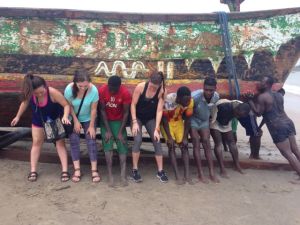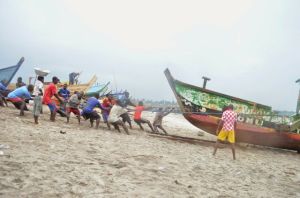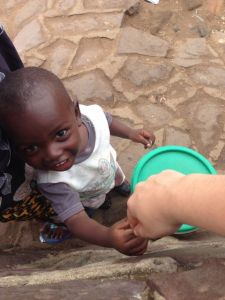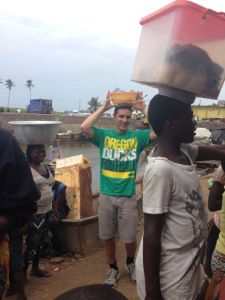Although Elmina and Cape Coast are beautiful towns, they are plagued by a tragic history. On Saturday, we learned some of that history while touring the castles there.
The Elmina and Cape Coast castles were two of the largest operating slave castles in West Africa, with the majority of slaves held there being sent to America and the Caribbean. The treatment of the slaves was horrific. They were kept inside pitch black rooms that had only one small window for ventilation. A series of trenches were dug into the ground to collect human waste. When it rained, the water would come in through the small window and wash the waste through the trenches and out to sea. Sometimes this system would fail, and slaves would be left sitting in up to a foot of their own waste. Those who tried to escape were sent to the condemned cell, where they would die within three days from suffocation and starvation.
At the end of the tour, the guide pointed out this plaque on the wall. It was donated as a gift by the Council of West African Chiefs, who acknowledged that they helped contribute to slavery by capturing and selling their own people.
 It reads, “In everlasting memory of the anguish of our ancestors. May those who died rest in peace, may those who return find their roots, may humanity never again perpetrate such injustice against humanity. We, the living, vow to uphold this.”
It reads, “In everlasting memory of the anguish of our ancestors. May those who died rest in peace, may those who return find their roots, may humanity never again perpetrate such injustice against humanity. We, the living, vow to uphold this.”
After reading the plaque, our tour guide gave a powerful speech. She reminded us of the atrocities that occurred in the castle, urging blacks and whites to stop focusing on their differences, and instead find unity in their similarities.

With this message in mind, a few of my roommates and I walked to the shore to watch a group of Ghanaian fishermen pull their boat up the beach. At first we were nervous, and feared that we would not be welcome there. But after a few minutes, the fishermen welcomed us with open arms, and even invited us to help. We squatted at the front of the boat, lifting it up with our butts, while about twenty men at the back of the boat used two ropes to drag it up the beach. All the while, the group chanted to enhance morale.

When it was time to say goodbye to our fishermen friends, we walked back to town and met the group at a restaurant. While we were waiting for everyone to arrive, we met some local kids. I laughed as I watched three young girls take turns teaching my roommates how to balance bins on their heads. As I was watching them, I felt something touch my arm, which I was resting on the wall in front of  me. I looked down and saw a little boy, about three years old, looking up at me from the other side. He grabbed my hand and began to trace his tiny brown fingers over my pale white skin. As he interlocked his hand with mine, I thought back to the welcoming fishermen, and to the tour guide’s speech. I looked over at the young girls, who were still trying to help Spencer balance their bucket on his head. As I took all of this in, I couldn’t help but wonder why these people are so eager to understand us, yet the majority of Americans do not take the time to understand them.
me. I looked down and saw a little boy, about three years old, looking up at me from the other side. He grabbed my hand and began to trace his tiny brown fingers over my pale white skin. As he interlocked his hand with mine, I thought back to the welcoming fishermen, and to the tour guide’s speech. I looked over at the young girls, who were still trying to help Spencer balance their bucket on his head. As I took all of this in, I couldn’t help but wonder why these people are so eager to understand us, yet the majority of Americans do not take the time to understand them.
Even within our country’s borders, we often don’t take the time to understand difference. How frequently do we see someone who doesn’t look like us or act like us, and instead of interacting with them, we stare in disbelief or shyly look away? Ghana may be a developing country, but in some ways it is further developed than my own. Despite our white skin, they accept us into their communities, yet we are so resistant to difference that we treat many of our own people like second-class citizens.
Since coming to Africa, I have opened my heart and my mind to people who are different than myself. In doing so, I have learned so much about the world, and have had some of the greatest experiences of my life. No matter where you are in the world today, I challenge you to get to know people that you would usually ignore, people who you have never taken the time to understand. You’ll be surprised by what you’ll learn!

